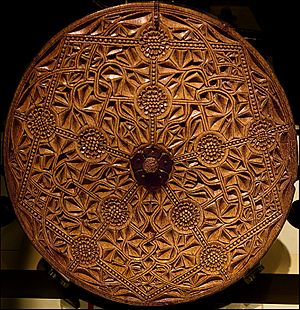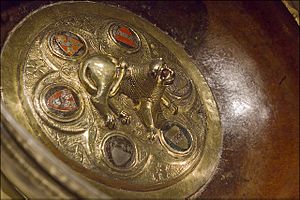Bute mazer facts for kids

The Bute Mazer, also called the Bannatyne Mazer, is a special drinking cup from the Middle Ages. It's a type of cup known as a mazer, which was often used for sharing drinks at big feasts and gatherings.
This amazing cup has a wooden bowl and a fancy silver-gilt (silver covered in a thin layer of gold) decoration in the middle. Experts believe the main part of the cup was made between 1314 and 1327. This date comes from the heraldry, which are the special symbols and designs on the cup. The rim and a cover were added later, around the year 1500.
The Bute Mazer is the oldest Scottish mazer still around today. It's also one of the oldest and most detailed mazers found in Britain. The cup has a long history connected to the Isle of Bute, an island off the west coast of Scotland. Its other name, Bannatyne Mazer, comes from Ninian Bannatyne. He was a landowner from Kames who owned the cup in the 1500s and had his name carved on its edge. Today, the Bannatyne family has loaned this historic cup to the National Museum of Scotland in Edinburgh, where you can see it.
The Mazer's Story
The Bute Mazer was likely ordered by the FitzGilbert or Gilbertson family. Their family symbols appear on the cup. They were an important family, though not as powerful as some of the very biggest noble families whose symbols are also on the mazer.
Some people think that King Robert the Bruce (who ruled Scotland from 1306 to 1329) might have used this cup. He may have used it at Rothesay Castle on the Isle of Bute. At that time, Rothesay was the home of Walter Stewart, who was a very important Scottish leader.
The six coats of arms on the mazer belong to six leading Scottish noble families. One of these is the family of Walter Stewart. Three of the families represented on the cup also had members who signed the Declaration of Arbroath. This was a very important letter written in 1320 that declared Scotland's independence from England.
What the Mazer Looks Like
The main bowl of the Bute Mazer is made from maple wood, shaped on a lathe. The base, or foot, of the cup is made of silver. In the 1500s, when the Bannatyne family owned the cup, silver and silver-gilt straps and a new rim were added. A goldsmith from Glasgow named Peter Lymeburner might have done this work.
Inside the bottom of the bowl, there's a metal decoration called a boss. This boss has a detailed, grinning lion lying down, looking up at you. The lion is surrounded by six coats of arms.
The lion was made by pouring metal into a mold. It has red enamel eyes and was attached to the boss with pins and solder. The rest of the boss is decorated with wyverns (dragon-like creatures), cinquefoils (five-leaf shapes), and a strawberry plant design around the shields. On the outside of the cup, there are six decorated straps that connect the rim to the foot. These straps were added during the updates around 1500.
Experts believe the mazer was made in Scotland around 1320. The style of the cup is very strong and well-made. The designs between the shields use an early Scottish attempt at a special type of enamel called translucent basse taille. This technique was quite new in Europe at the time.
The silver rim and the whale bone cover were added around 1500. They are not quite as detailed as the older parts of the cup. They were likely replacements for earlier parts that were lost or damaged.
Family Symbols (Heraldry)
Some people think the lion in the center of the mazer might represent King Robert the Bruce. However, others believe the lion looks too informal to be a symbol for a king.
The six enamelled shields on the boss show the coats of arms of six important families who supported King Robert the Bruce. If you look clockwise from between the lion's front paws, you'll see:
- The House of Stewart, represented by Walter Stewart, who was a very important leader.
- The Douglas family, represented by Sir James Douglas, who was a close friend and commander for Bruce.
- Walter FitzGilbert, an ancestor of the later Dukes of Hamilton.
- John FitzGilbert, who was a local official (a Baillie) on Bute and possibly Walter's brother.
- The Crawford of Loudoun family.
- The Menteith family, which was another branch of the Stewart family.
It's interesting that the Douglas coat of arms is to the lion's right. This might show Sir James Douglas's important role as Bruce's main commander. The Stewart coat of arms is between the lion's paws. This could be because Walter Stewart was married to King Bruce's daughter, Marjorie. Their son later became King Robert II in 1371, and he was the first king from the House of Stewart.



